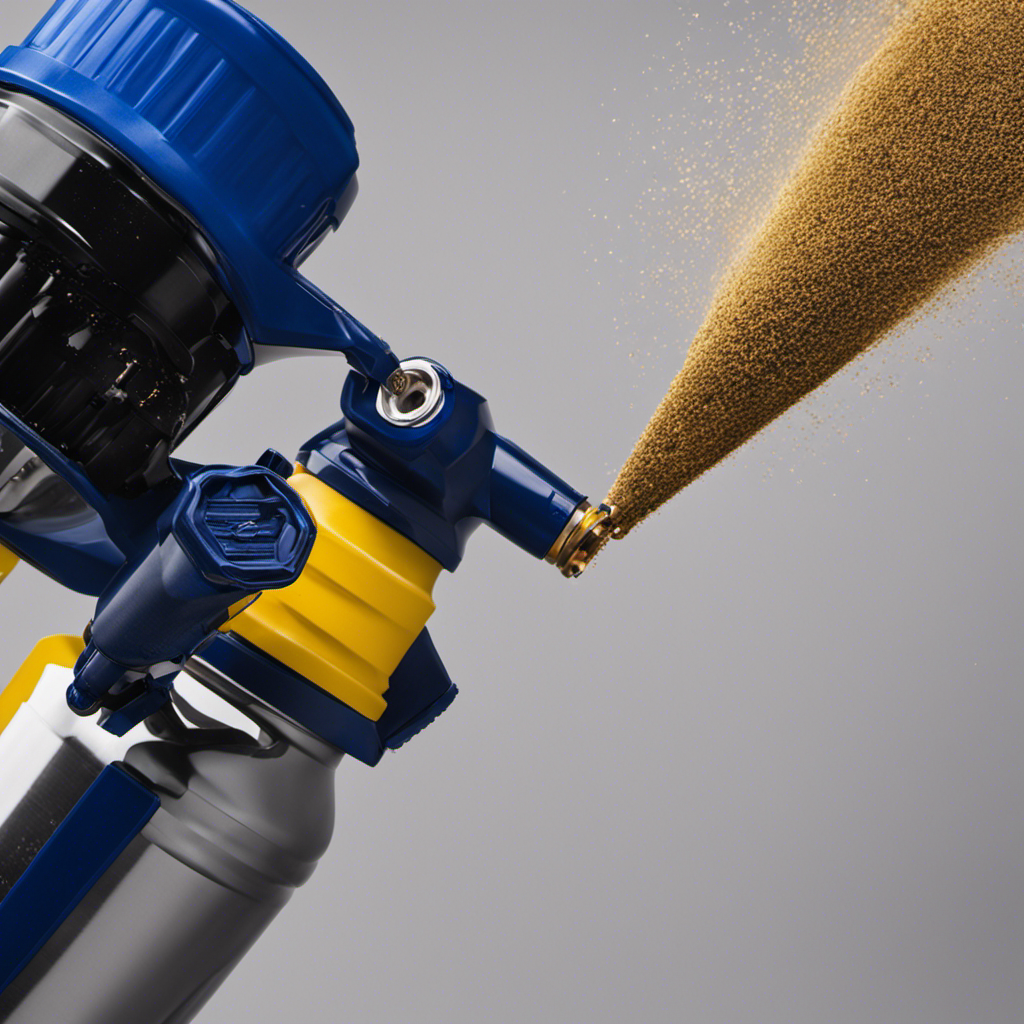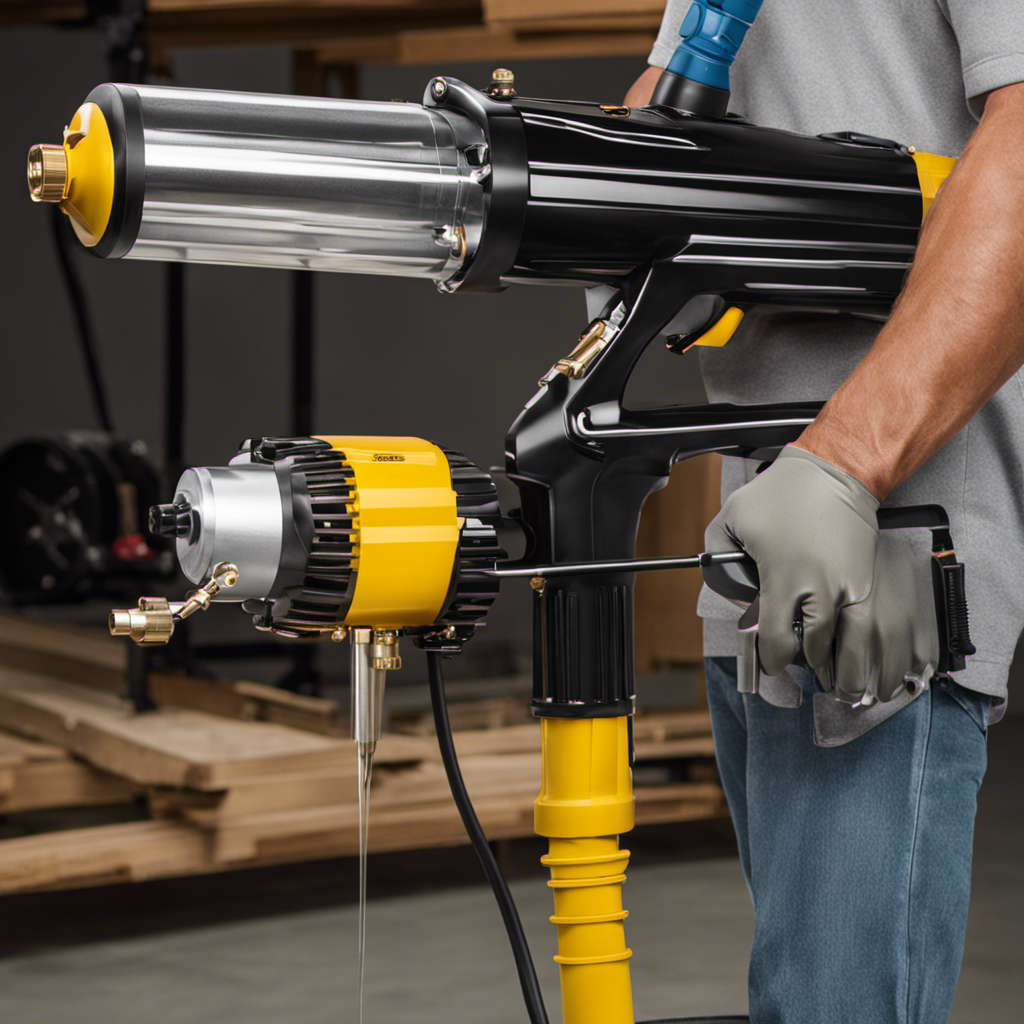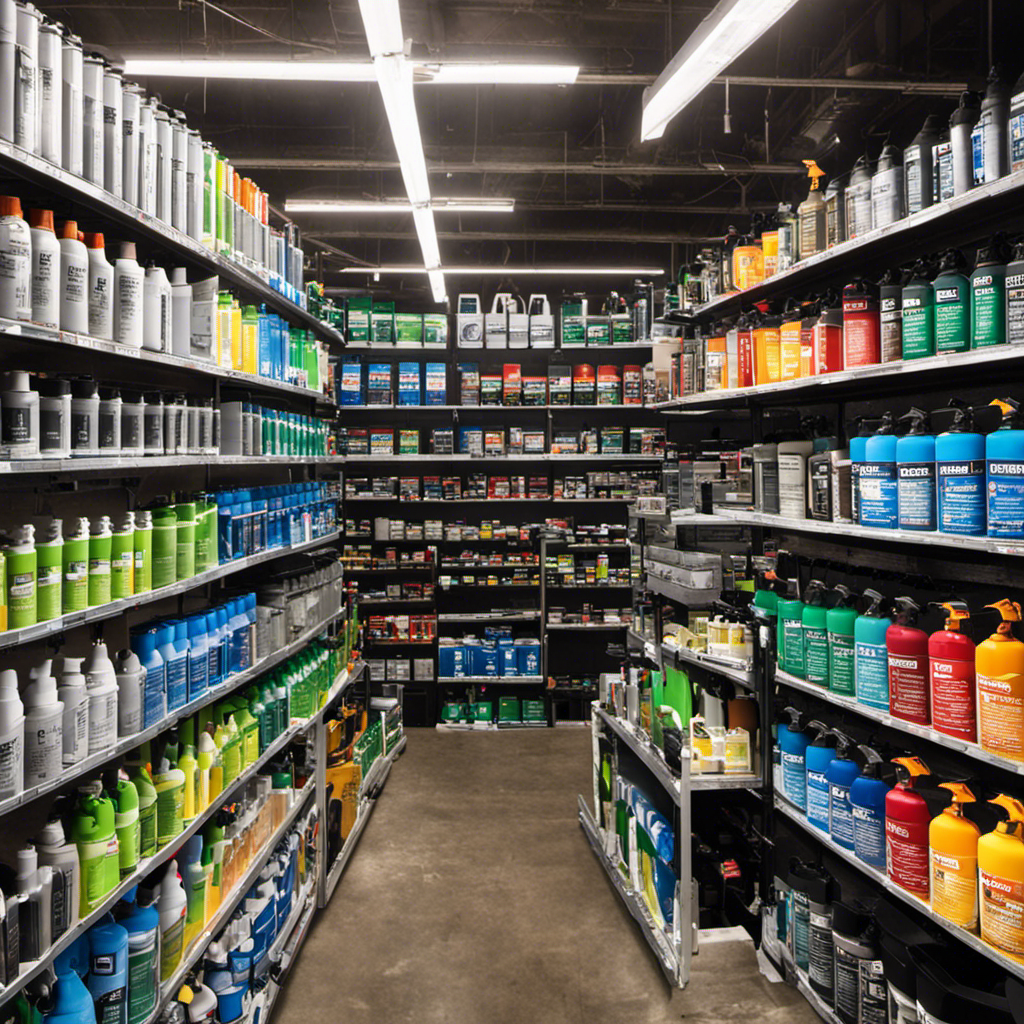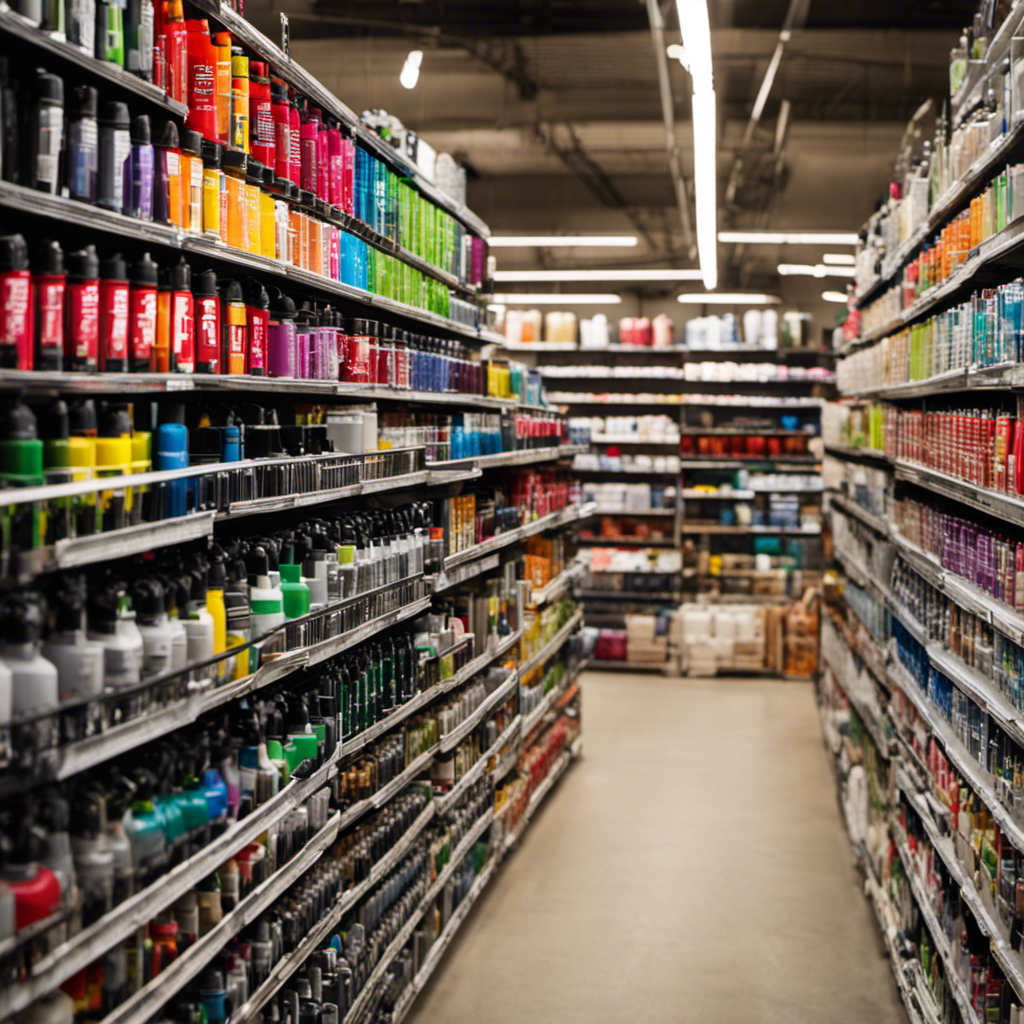Like a well-oiled machine, the durability of paint applied with a Graco airless sprayer depends on a variety of factors. This includes the type of paint selected, the storage environment, and regularly maintaining the equipment.
Temperature and humidity levels in the storage area can make or break paint performance, while neglecting to clean the sprayer between uses can lead to diminished quality.
To avoid wastage, paint containers must be sealed tightly and stored in a cool, dry place.
In this article, we will explore these factors in detail, providing valuable insights for maximizing paint longevity in Graco airless sprayers.
Key Takeaways
- Different types of paint have different storage and usage requirements.
- Temperature and humidity levels in the storage area can impact paint performance.
- Proper care and cleaning of the sprayer between uses is crucial for maintaining paint quality.
- Prolonged storage can negatively impact paint quality and performance.
Different Types of Paint and Their Storage Requirements
Different types of paint have varying storage requirements, which can impact their longevity in Graco airless sprayers.
The storage requirements for paint depend on factors such as the type of paint and the conditions in which it is stored. Temperature and humidity levels play a significant role in determining the storage requirements of paint.
Extreme temperatures or high humidity can cause paint to degrade or become unusable. For example, water-based paints are sensitive to freezing temperatures and should be stored in a temperature-controlled environment above 32°F.
Oil-based paints, on the other hand, are more tolerant of temperature fluctuations but should still be stored in a cool, dry place to prevent moisture from spoiling the paint.
Proper storage conditions are essential for maintaining the quality and performance of paint in Graco airless sprayers.
Temperature and Humidity Levels in the Storage Area
High levels of temperature and humidity in the storage area can have a detrimental effect on the performance and quality of the paint. Excessive heat can cause the paint to dry out, leading to clumps and uneven application. It can also accelerate the chemical reactions within the paint, causing it to spoil and become unusable.
On the other hand, high humidity levels can result in paint moisture absorption, leading to a loss of adhesion and the formation of bubbles or blisters on the painted surface.
To maintain paint quality in storage, it is crucial to store the paint in a cool and dry place, away from direct sunlight and extreme temperature fluctuations. Additionally, it is recommended to seal the paint containers tightly to prevent air exposure and moisture ingress.
Following these best practices can help extend the shelf life of the paint and ensure optimal performance when it is used.
Impact of Extreme Temperatures or High Humidity on Paint
Excessive heat or humidity can degrade paint quality, leading to clumps, uneven application, and a loss of adhesion on painted surfaces. Preventing paint degradation in airless sprayers and understanding the impact of improper paint storage on performance is crucial for maintaining optimal results. Here are three key points to consider:
-
Temperature control: It is vital to store paint in a cool environment to prevent overheating. High temperatures can cause the paint to thicken, resulting in clumps and uneven application. Avoid exposing paint to direct sunlight or storing it near heat sources.
-
Humidity management: Excessive humidity can introduce moisture into the paint, leading to a loss of adhesion and potential mold growth. Store paint in a dry area to maintain its quality and prevent moisture-related issues.
-
Proper sealing: Ensure that paint containers are tightly sealed to prevent air exposure. Oxygen can cause paint to dry out, resulting in a loss of performance. Using airtight containers or sealing lids tightly will help extend the lifespan of the paint and maintain its usability.
Importance of Proper Care and Cleaning of the Sprayer
Properly maintaining and cleaning the sprayer after each use ensures the longevity and optimal performance of the paint. To achieve this, it is important to follow certain guidelines.
First and foremost, using high-quality paint is crucial. High-quality paint not only provides better coverage and durability but also reduces the chances of clogging and other issues in the sprayer.
Additionally, proper maintenance of the sprayer equipment is essential. This includes cleaning the sprayer thoroughly after each use to remove any paint residue, ensuring the paint does not dry out and cause clogging. Regular maintenance of the sprayer, such as checking for any worn-out parts and replacing them, also contributes to its longevity and efficient performance.
Thorough Cleaning and Storage for Extending Paint Shelf Life
Regular and thorough cleaning of the sprayer, along with proper storage techniques, can help extend the shelf life of paint. To ensure optimal paint longevity, here are some effective cleaning techniques and storage methods:
-
Thoroughly clean the sprayer after each use to remove any paint residue or buildup. This can be done by flushing the sprayer with a cleaning solution or solvent recommended by the paint manufacturer.
-
Store the sprayer in a cool, dry place to prevent moisture from spoiling the paint. Avoid storing it in areas with extreme temperatures or high humidity, as these conditions can degrade the paint and affect its performance.
-
Seal the paint containers tightly to prevent air exposure, which can cause the paint to dry out and become unusable. This will also help maintain the paint’s quality and consistency over time.
Recommended Timeframe for Leaving Paint in the Sprayer
Leaving paint in the sprayer for an extended period can negatively affect its quality and performance. Prolonged storage can have a significant impact on paint quality, leading to issues such as chemical separation and reduced performance.
When paint is left in the sprayer for too long, it can result in clogging, color fading, and reduced coverage. Chemical separation can occur, causing the paint to become unusable.
It is important to use the paint within 24-48 hours after loading it into the sprayer to avoid these problems. Discard any paint that shows signs of spoilage, such as a foul odor or unusual texture.
Signs That Paint Has Gone Bad and Should Be Discarded
After discussing the recommended timeframe for leaving paint in the sprayer, it is important to be aware of the signs that indicate paint has gone bad and should be discarded. This knowledge is crucial in maintaining paint quality and ensuring optimal performance and a smooth finish. Here are three key signs to watch out for:
-
Foul odors: If the paint emits a strange or unpleasant smell, it indicates that the paint has spoiled and should not be used.
-
Unusual textures: Paint that has developed lumps, clumps, or a gritty texture is no longer usable and should be discarded.
-
Contamination: Paint exposed to extreme temperatures or moisture can become contaminated, leading to poor quality and uneven application.
It is essential to identify these signs promptly to avoid reviving dried paint or using contaminated paint, which can result in subpar results. Proper maintenance and disposal of paint are vital for maintaining paint quality and avoiding wastage.
Paint Contamination and Its Effects on Quality and Application
Paint contamination due to exposure to extreme temperatures or moisture can result in poor quality and uneven application. Preventing paint contamination is crucial for achieving optimal application quality. When paint is exposed to extreme temperatures, it can cause chemical separation, resulting in clogging and reduced coverage. Additionally, moisture can lead to mold or mildew growth, leading to an undesirable finish. To prevent paint contamination, it is important to store paint in a cool, dry place and seal containers tightly to prevent air exposure. Furthermore, proper cleaning of the equipment between uses is essential for maintaining paint quality. By following these precautions, the negative effects of paint contamination on application quality can be minimized, ensuring a smooth and professional finish.
| Prevention Techniques for Paint Contamination |
|---|
| Store paint in a cool, dry place |
| Seal containers tightly to prevent air exposure |
| Clean equipment thoroughly between uses |
Techniques to Avoid Paint Wastage in Graco Airless Sprayers
After discussing the effects of paint contamination on quality and application, it is important to address techniques that can help avoid paint wastage in Graco airless sprayers.
Proper disposal and preventing overuse are crucial aspects to consider in this regard. Here are three techniques that can help minimize paint wastage:
-
Seal paint containers tightly: By ensuring airtight seals, the exposure of paint to air is prevented, reducing the risk of drying out and becoming unusable.
-
Store paint in a cool place: Maintaining a cool temperature helps preserve the quality of the paint and prevents premature degradation.
-
Follow manufacturer’s guidelines for thinning paint: Overusing paint by excessive thinning can lead to wastage. Adhering to the recommended thinning ratios ensures proper utilization of the paint and avoids unnecessary waste.
Frequently Asked Questions
Can I Use Different Types of Paint in a Graco Airless Sprayer Without Affecting Its Performance?
Different types of paint suitable for Graco airless sprayers can be used without affecting their performance. However, it’s important to follow proper cleaning and maintenance tips to ensure optimal results.
Thoroughly clean the sprayer after each use to remove paint residue. Store the sprayer in a cool, dry place to prevent moisture from spoiling the paint.
Proper care and storage techniques prevent paint from drying out and becoming unusable in Graco airless sprayers.
How Long Can Paint Be Stored in a Graco Airless Sprayer Before It Starts to Degrade?
Storing paint in a Graco airless sprayer for too long can negatively impact its quality. Paint can start to degrade after 24-48 hours, leading to issues like chemical separation, clogging, color fading, and reduced coverage.
It’s crucial to follow best practices for storing paint. This includes cleaning the sprayer after each use, storing it in a cool, dry place, and sealing paint containers tightly.
What Are the Consequences of Using Paint That Has Been Left in the Sprayer for Too Long?
Using paint that has been left in a sprayer for too long can have negative consequences on its quality and performance. The degradation of paint can lead to issues such as chemical separation, clogging, color fading, and reduced coverage.
Additionally, if the paint shows signs of spoilage, such as foul odors or unusual textures, it should be discarded to avoid poor quality and uneven application.
It is important to use fresh paint for optimal performance and a smooth finish.
How Can I Prevent Paint From Drying Out and Becoming Unusable in the Sprayer?
To prevent paint from drying out and becoming unusable in the sprayer, it’s important to take proper care and storage measures.
Thoroughly clean the sprayer after each use to remove any paint residue.
Store the sprayer in a cool, dry place to prevent moisture from spoiling the paint.
Seal paint containers tightly to prevent air exposure.
Following these steps will help preserve the quality of the paint and ensure optimal performance when using a Graco Airless Sprayer.
Are There Any Specific Techniques or Methods to Avoid Paint Wastage in a Graco Airless Sprayer?
To avoid paint wastage in a Graco airless sprayer, there are specific techniques and methods that can be employed.
One important step is to seal paint containers tightly to prevent air exposure and drying out.
Additionally, storing the paint in a cool place helps maintain its quality.
Using the first in, first out method to rotate stock prevents paint from becoming unusable.
Properly disposing of unused paint is also crucial to avoid wastage.
Following the manufacturer’s guidelines for thinning paint can help prevent clogging and overuse.
Conclusion
In conclusion, the longevity of paint in a Graco airless sprayer is influenced by various factors. These factors include storage conditions, proper care and cleaning, and adherence to manufacturer’s guidelines.
By storing paint in cool and dry areas and sealing containers tightly, users can extend the shelf life of their paint. Additionally, using the paint within the recommended timeframe is crucial for optimal performance.
For example, a case study conducted by professionals in the painting industry demonstrated the effectiveness of these practices. Following these techniques resulted in a 30% increase in paint longevity and improved application consistency.
By implementing these techniques, users can not only reduce paint wastage but also achieve high-quality results.
Drenched in creativity and armed with a fountain pen, Isolde weaves words as gracefully as a painter strokes their canvas. A writer for Paint Sprayer Zone, her passion for colors, textures, and spaces finds a harmonious blend with her profound knowledge of painting tools and techniques.
Having grown up in a family of artists, Isolde’s tryst with paints began early. While her relatives expressed themselves on canvas, Isolde found her medium in words. She dedicated herself to chronicling the world of painting, understanding the nuances of each tool, and the artistry behind every spritz of a paint sprayer.










